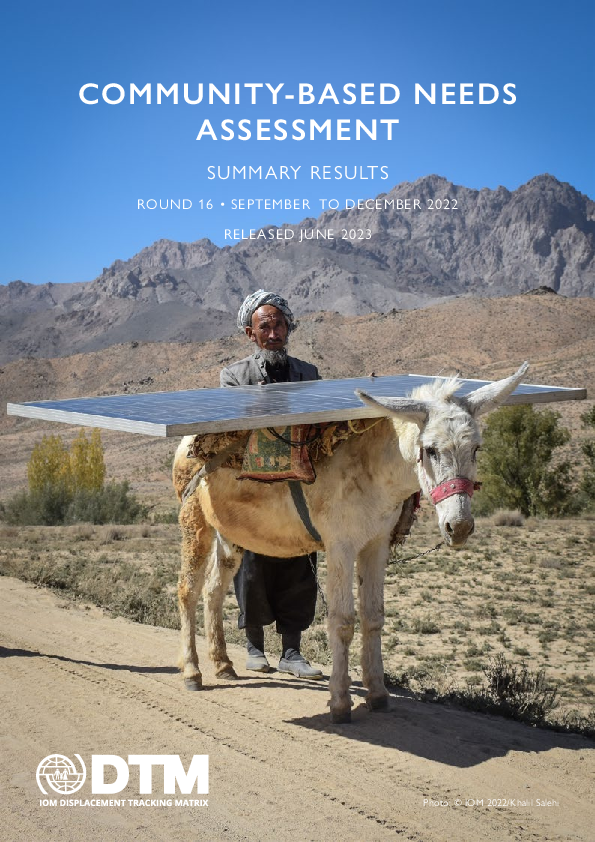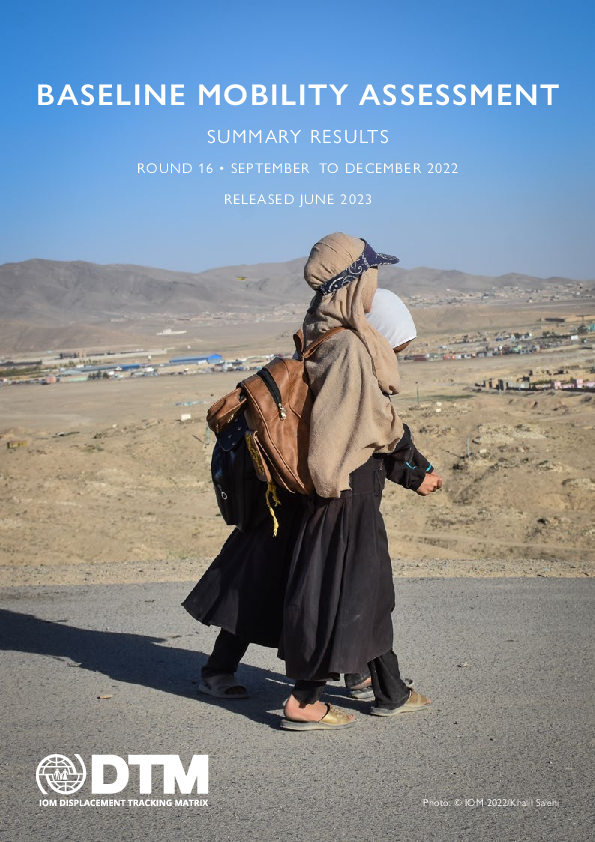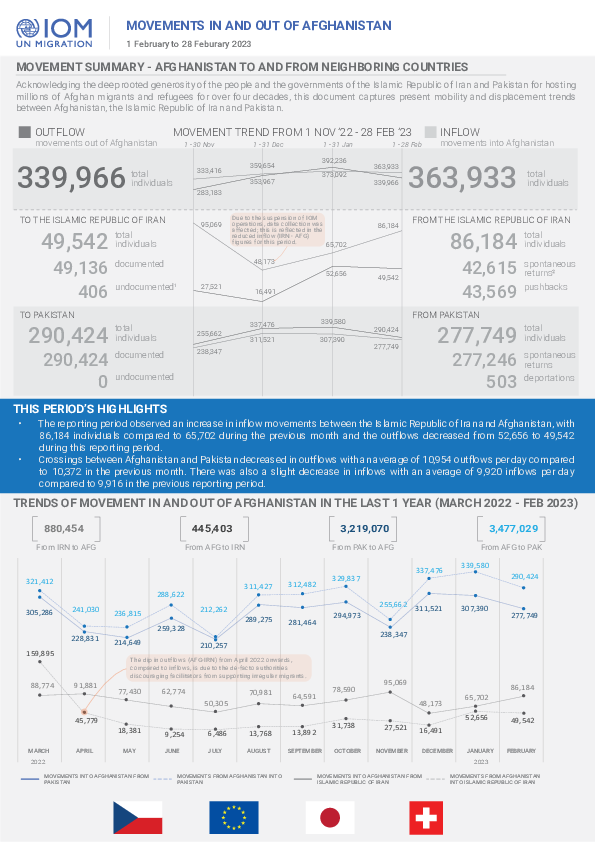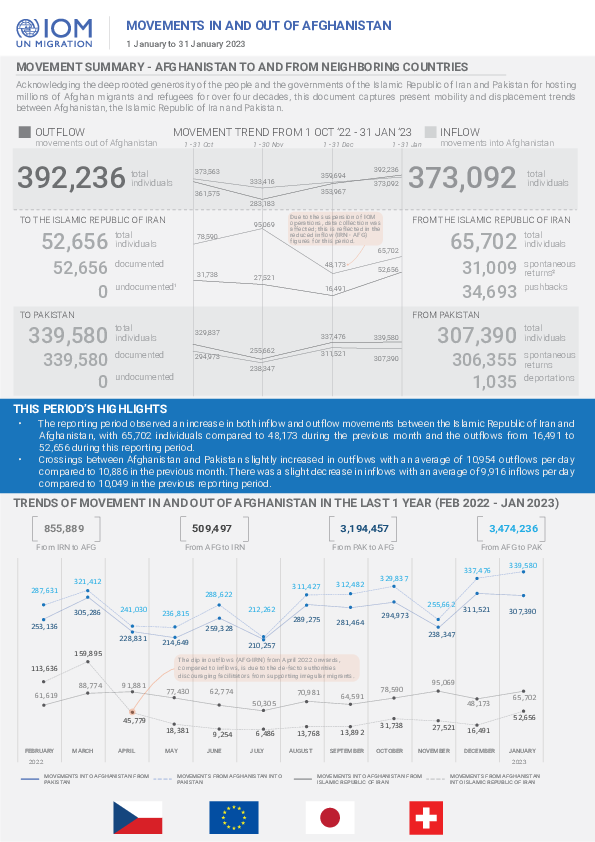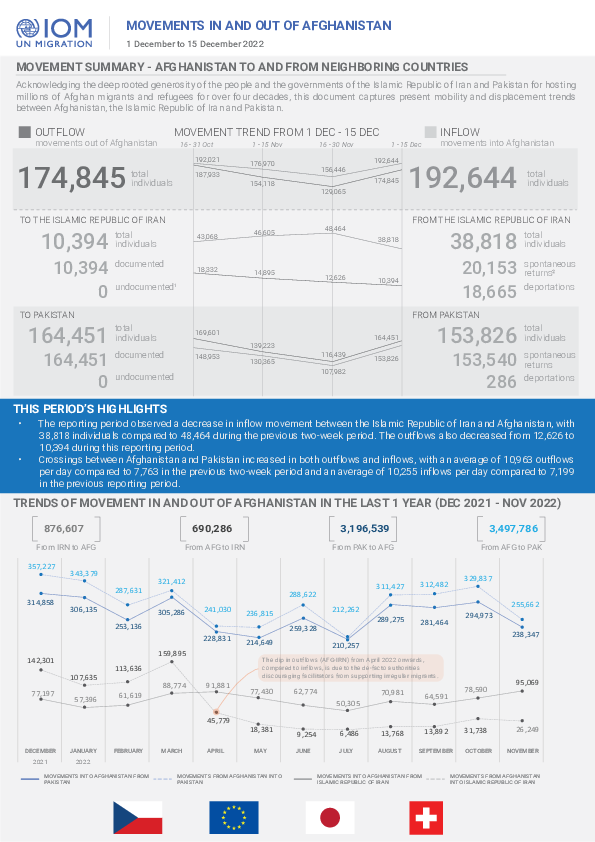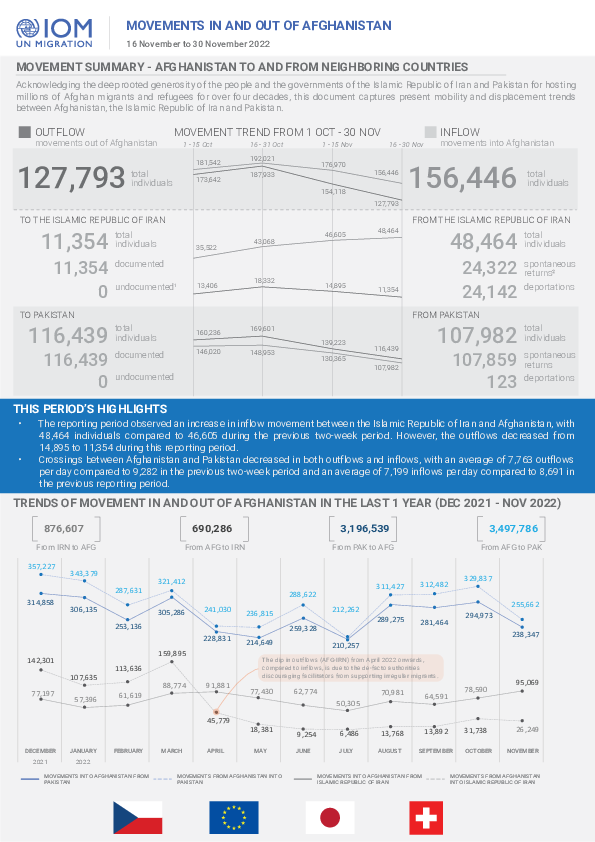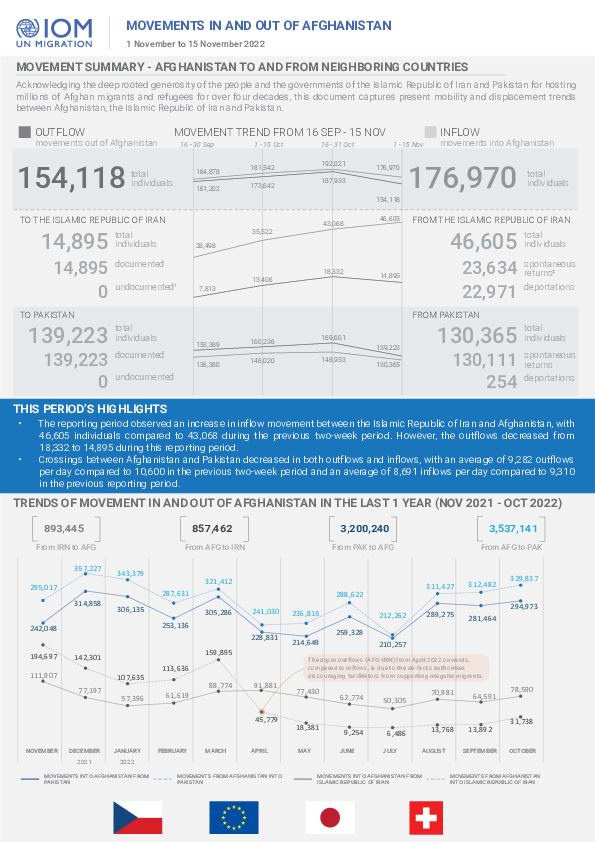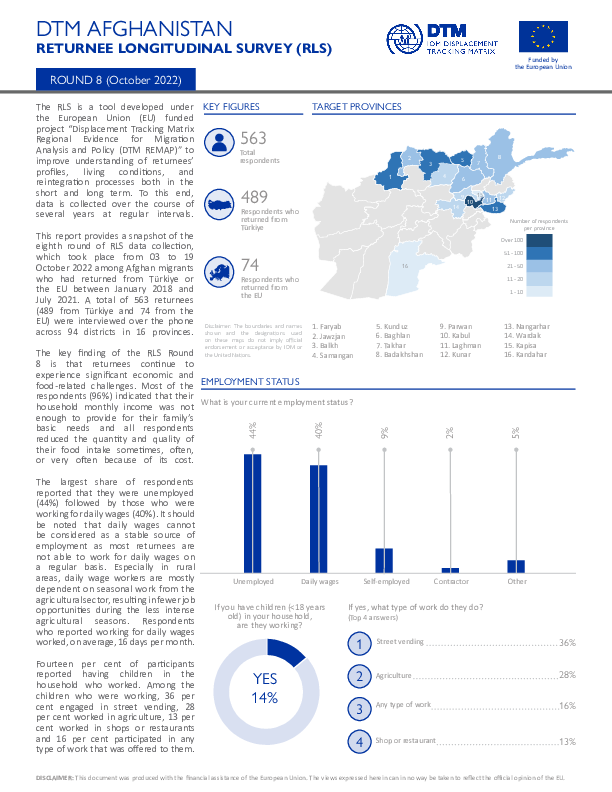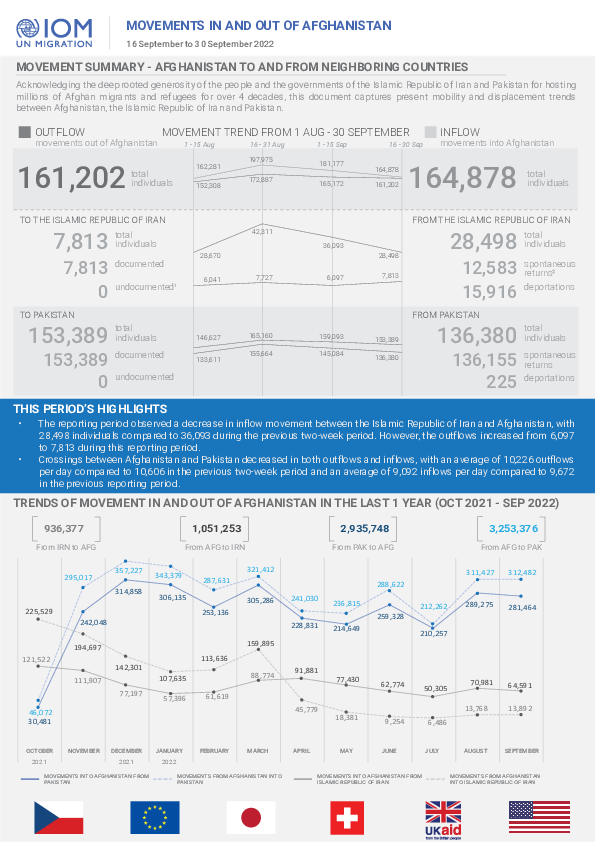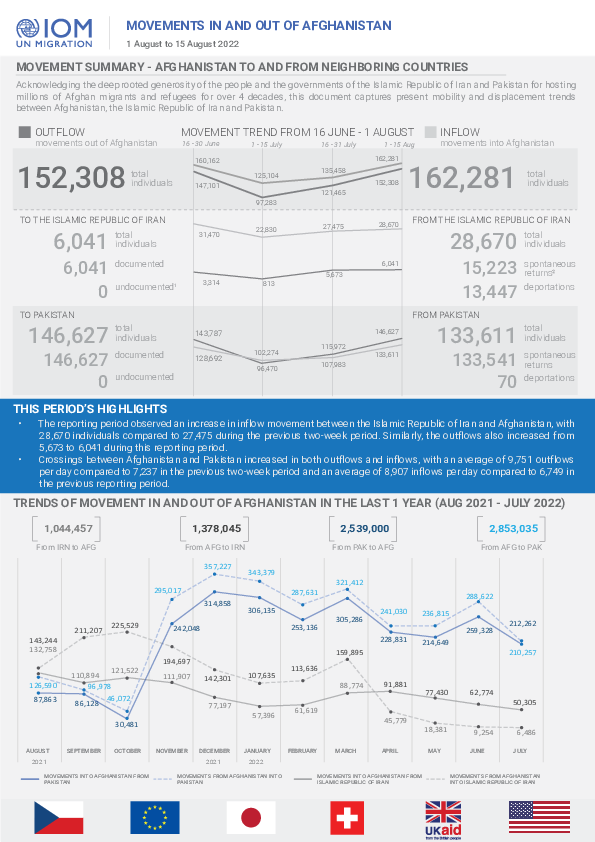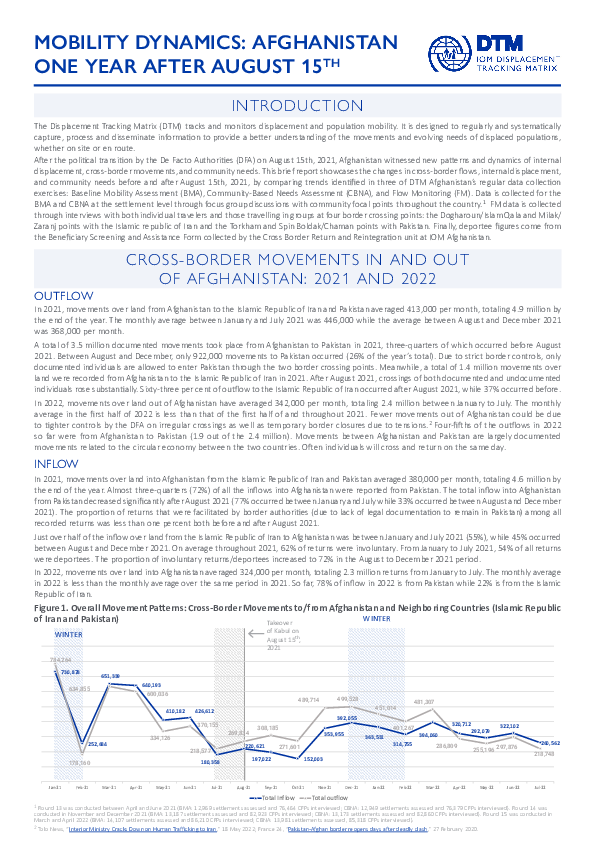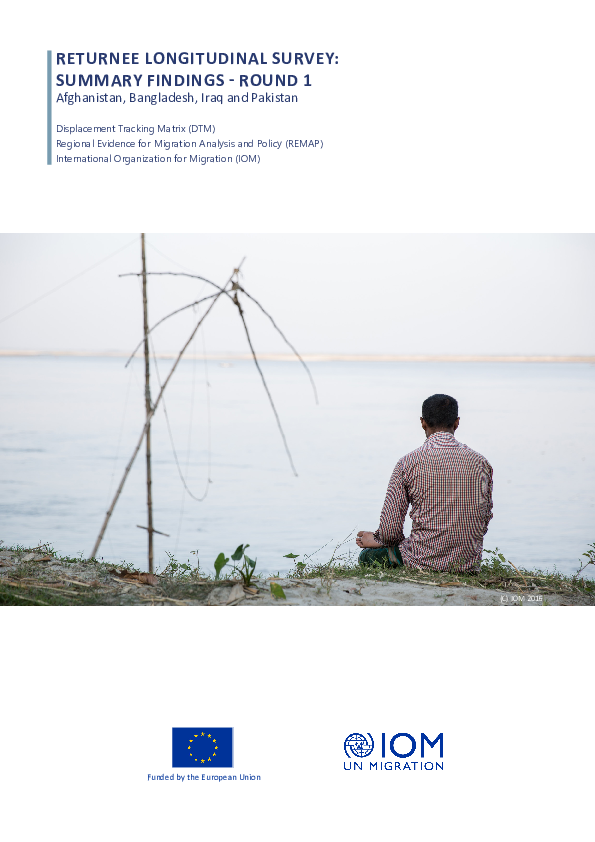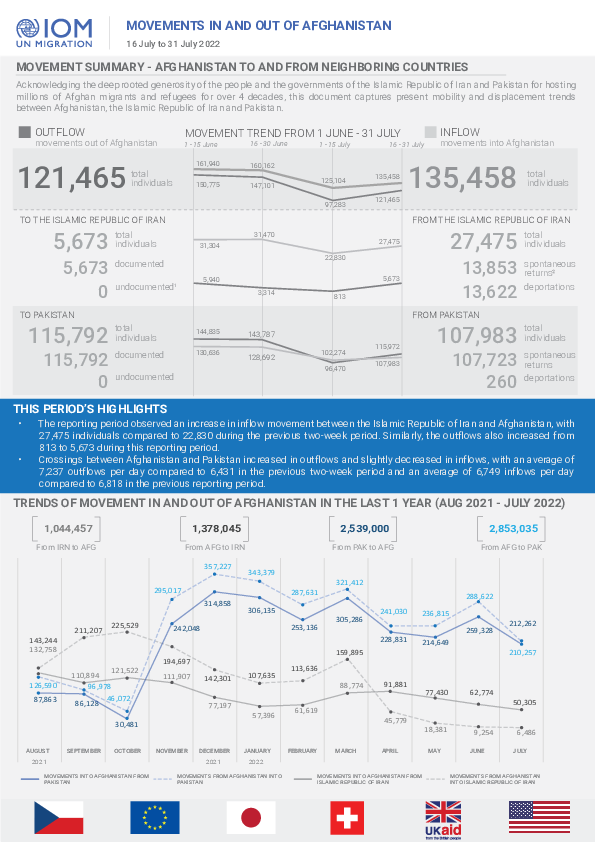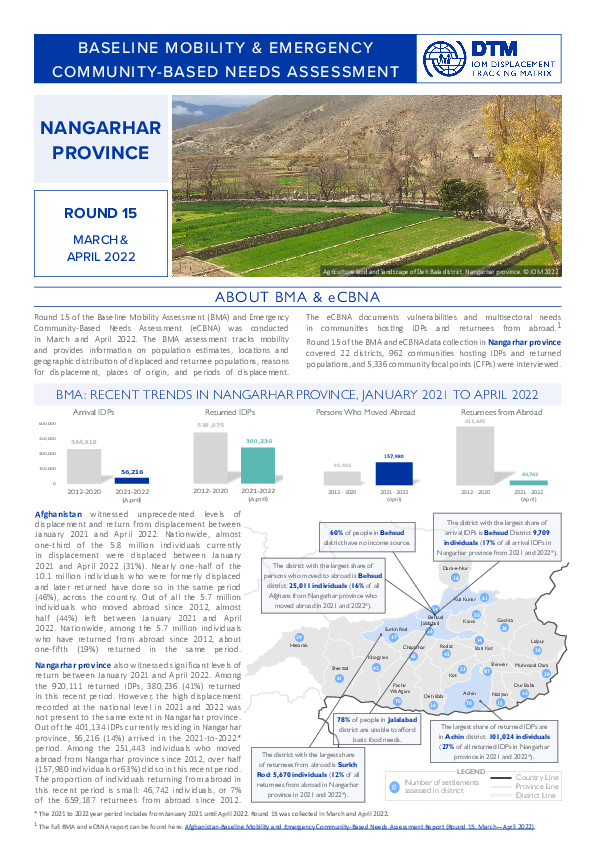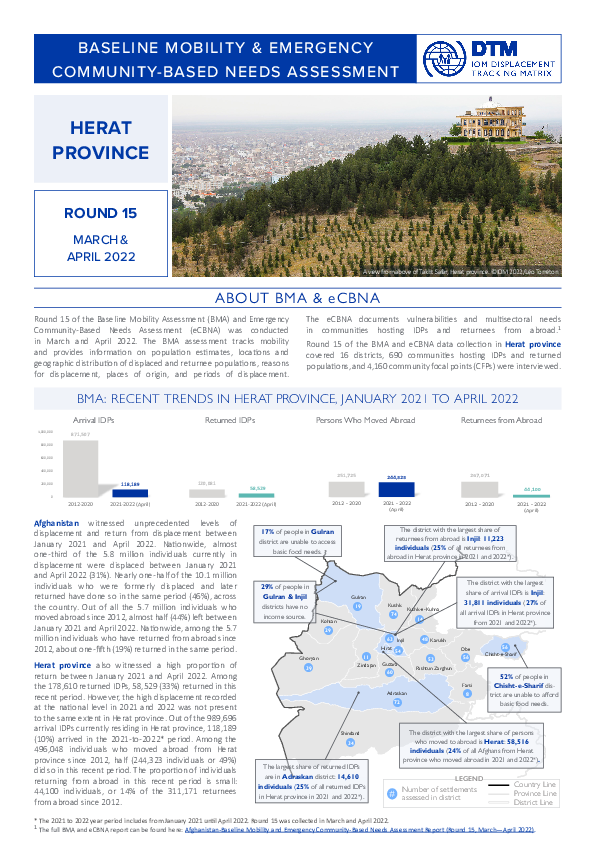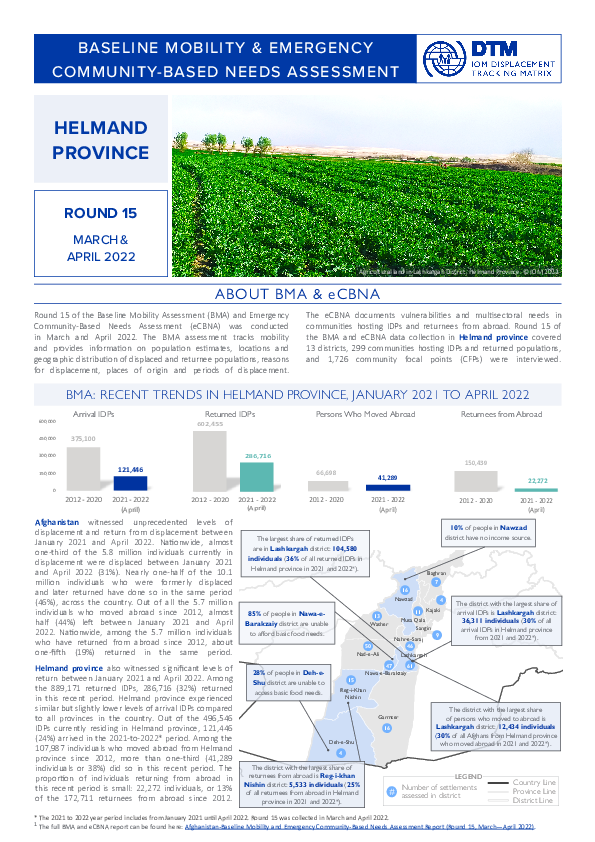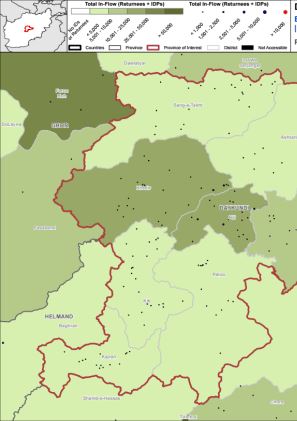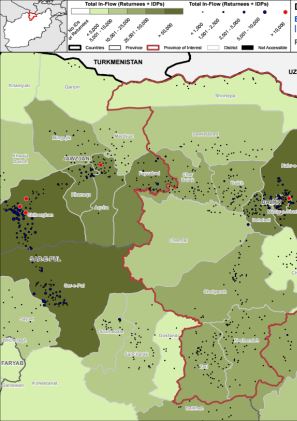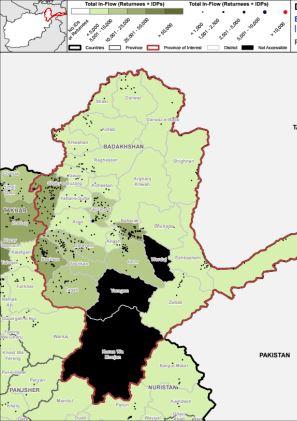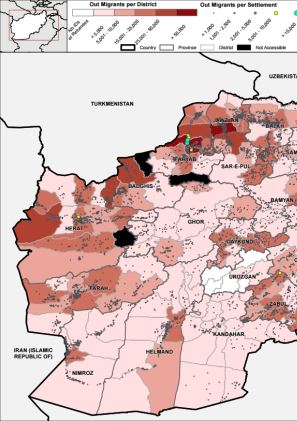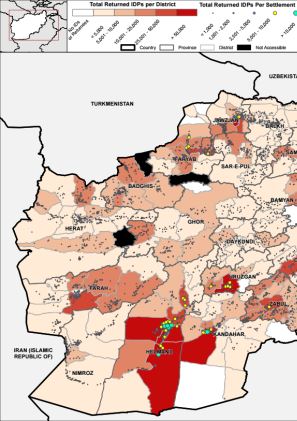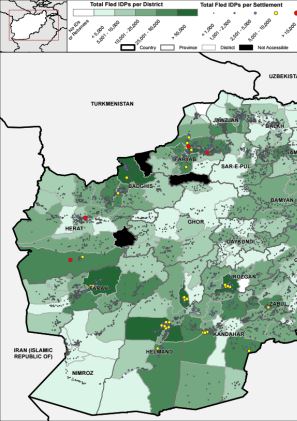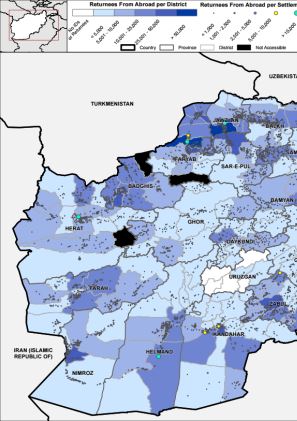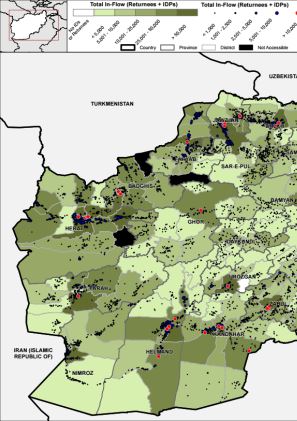-
Countries
-
Data and Analysis
-
Special Focus
-
Crisis Responses
Afghanistan
Afghanistan
IDPs tracked
Displacement Movements
4,187,000
IDMC 2023
Data collection round
About Afghanistan
The Displacement Tracking Matrix (DTM) is an information management system of tools and methodologies used to track and monitor displacement and population mobility. In Afghanistan, IOM activated the DTM programme in January 2017 in response to the substantial increase of Afghans returning home from neighbouring countries, as well as record levels of internal displacement. DTM in Afghanistan is designed to regularly and systematically capture, process and disseminate multi-layered information about the population sizes, locations, geographic distribution, movements, vulnerabilities, evolving multisectoral needs, and the drivers of migration of returnees, IDPs, migrants and mobile populations. DTM implements baseline mobility assessments, flow monitoring, registrations, and various migration surveys to provide an essential evidence base that enables decision-makers and humanitarian, reintegration and development partners to maximize resources and deliver efficient, better-targeted, mobility-sensitive and sustainable humanitarian; reintegration, community stabilization and development programming.
The value-added impact of DTM in Afghanistan is to inform action and results for people in need. DTM Afghanistan implements its activities at both the national and provincial levels. DTM works closely with other (IOM) programmes through referring identified populations in need of assistance at flow monitoring points to IOM’s Cross Border Return and Reintegration, Protection, Humanitarian Assistance, and Reintegration and Development (RADA) programmes. DTM Afghanistan also supports humanitarian partners and clusters, including WFP, FAO, UNHCR, IRC, DRC, NRC, and WHO, among many others, by providing emergency tracking updates in large-scale or sudden onset movements, such as emergency event tracking and drought response. Furthermore, stabilization and development actors, including IOM’s RADA programme, and the World Bank leverage DTM’s information to select priority communities and districts with higher concentrations of IDPs and returnees to receive reintegration and livelihoods assistance and improvements to core infrastructure and essential services. In support of health partners, including WHO, UNICEF, and the Humanitarian Health Cluster, DTM data informs the selection of priority, at-risk districts, border areas, communities, and health facilities in need of strengthened capacity, response, surveillance, and risk education for polio, TB, COVID-19, and other infectious diseases.
Contact
Modher ALHAMADANI
Senior Programme Coordinator - DTM
malhamadani@iom.int
DTM AFGHANISTAN
DTMAFGHANISTAN@iom.int
Current Donors
- Republic of Korea
- Norway
- CERF
- Canada
- Italy
- EU
- FCDO
Afghanistan — Community-Based Needs Assessment Report, Round 16 (September-December 2022)
DTM Afghanistan conducts the Community-Based Needs Assessment (CBNA) as an integral component of DTM's Baseline Mobility Assessment (BMA), which (in a jointly released report) tracks mobility and displacement. The CBNA provides a comprehensive overview of the evolving vulnerabilities and mul
Afghanistan — Baseline Mobility Assessment Report, Round 16 (September-December 2022)
DTM has been conducting the Baseline Mobility Assessment (BMA) in Afghanistan since 2016 to track mobility, provide information on population estimates, locations and geographic distribution of displaced and returnee populations, reasons for displacement, places of origin and periods of displacem
Movement in and out of Afghanistan Snapshot (1-31 Mar 2023)
The snapshot captures present mobility and displacement trends between Afghanistan, the Islamic Republic of Iran and Pakistan.
Movement in and out of Afghanistan Snapshot (1-28 Feb 2023)
The snapshot captures present mobility and displacement trends between Afghanistan, the Islamic Republic of Iran and Pakistan.
Movement in and out of Afghanistan Snapshot (1-31 Jan 2023)
The snapshot captures present mobility and displacement trends between Afghanistan, the Islamic Republic of Iran and Pakistan.
Movement in and out of Afghanistan Snapshot (16- 31 Dec 2022)
The snapshot captures present mobility and displacement trends between Afghanistan, the Islamic Republic of Iran and Pakistan.
Movement in and out of Afghanistan Snapshot (01- 15 Dec 2022)
The snapshot captures present mobility and displacement trends between Afghanistan, the Islamic Republic of Iran and Pakistan.
Movement in and out of Afghanistan Snapshot (16-30 November 2022)
The snapshot captures present mobility and displacement trends between Afghanistan, the Islamic Republic of Iran and Pakistan.
Movement in and out of Afghanistan Snapshot (01- 15 November 2022)
The snapshot captures present mobility and displacement trends between Afghanistan, the Islamic Republic of Iran and Pakistan.
Movement in and out of Afghanistan Snapshot (16- 31 October 2022)
The snapshot captures present mobility and displacement trends between Afghanistan, the Islamic Republic of Iran and Pakistan.
Afghanistan — RLS - Snapshot Report Round 8 (October 2022)
To better understand the demographic profiles, living conditions and reintegration processes of Afghan returnees, IOM, under the EU-funded project “Displacement Tracking Matrix Regional Evidence for Migration Analysis and Policy (DTM REMAP)”, developed the Returnee Longitudinal Survey (RLS).
Movement in and out of Afghanistan Snapshot (01- 15 October 2022)
The snapshot captures present mobility and displacement trends between Afghanistan, the Islamic Republic of Iran and Pakistan.
Movement in and Out of Afghanistan Snapshot (16- 30 September 2022)
The snapshot captures present mobility and displacement trends between Afghanistan, the Islamic Republic of Iran and Pakistan.
Afghanistan — RLS - Snapshot Report Round 7 (Aug - Sept 2022)
To better understand the demographic profiles, living conditions and reintegration processes of Afghan returnees, IOM, under the EU-funded project “Displacement Tracking Matrix Regional Evidence for Migration Analysis and Policy (DTM REMAP)”, developed the Returnee Longitudinal Survey (RLS).
Movement in and Out of Afghanistan Snapshot (01- 15 September 2022)
The snapshot captures present mobility and displacement trends between Afghanistan, the Islamic Republic of Iran and Pakistan.
Movement in and Out of Afghanistan Snapshot (16- 31 August 2022)
The snapshot captures present mobility and displacement trends between Afghanistan, the Islamic Republic of Iran and Pakistan.
Afghanistan — RLS - Snapshot Report Round 6 (June - July 2022)
To better understand the demographic profiles, living conditions and reintegration processes of Afghan returnees, IOM, under the EU-funded project “Displacement Tracking Matrix Regional Evidence for Migration Analysis and Policy (DTM REMAP)”, developed the Returnee Longitudinal Survey (RLS).
Movement in and Out of Afghanistan Snapshot (01- 15 August 2022)
The snapshot captures present mobility and displacement trends between Afghanistan, the Islamic Republic of Iran and Pakistan.
Mobility Dynamics: Afghanistan One Year After August 15th
After the political transition by the De Facto Authorities (DFA) on August 15th, 2021, Afghanistan witnessed new patterns and dynamic of internal displacement, cross-border movements, and community needs.
REMAP - RLS Summary Findings: Afghanistan, Bangladesh, Iraq and Pakistan (Round 1)
To better understand the demographic profiles, living conditions and reintegration processes of returnees, IOM, under the EU-funded project “Displacement Tracking Matrix Regional Evidence for Migration Analysis and Policy (DTM REMAP)”, developed the Returnee Longitudinal Survey
Movement in and Out of Afghanistan Snapshot (16 - 31 July 2022)
The snapshot captures present mobility and displacement trends between Afghanistan, the Islamic Republic of Iran and Pakistan, between 16 July and 31 July 2022.
Afghanistan - Nangarhar Province: Baseline Mobility and Emergency-Community Based Needs Assessment, Round 15 (March-April 2022)
DTM has been conducting the Baseline Mobility Assessment in Afghanistan since 2016 to track mobility, provide information on population estimates, locations and geographic distribution of displaced and returnee populations, reasons for displacement, places of origin and periods of displacement.
Afghanistan - Herat Province: Baseline Mobility and Emergency-Community Based Needs Assessment, Round 15 (March-April 2022)
DTM has been conducting the Baseline Mobility Assessment in Afghanistan since 2016 to track mobility, provide information on population estimates, locations and geographic distribution of displaced and returnee populations, reasons for displacement, places of origin and periods of displacement.
Afghanistan - Helmand Province: Baseline Mobility and Emergency-Community Based Needs Assessment, Round 15 (March-April 2022)
DTM has been conducting the Baseline Mobility Assessment in Afghanistan since 2016 to track mobility, provide information on population estimates, locations and geographic distribution of displaced and returnee populations, reasons for displacement, places of origin and periods of displacement.
Pagination
Pagination
Afghanistan — Provincial Map — Farah — June 2019
This combined map provide information on Total Inflow, Returnees From Abroad, Arrival IDPs, Fled IDPs, Returned IDPs and Out Migrants on provincial level during the period of 2012 - June 2019.
Afghanistan — Provincial Map — Daykundi — June 2019
This combined map provide information on Total Inflow, Returnees From Abroad, Arrival IDPs, Fled IDPs, Returned IDPs and Out Migrants on provincial level during the period of 2012 - June 2019.
Afghanistan — Provincial Map — Bamyan — June 2019
This combined map provide information on Total Inflow, Returnees From Abroad, Arrival IDPs, Fled IDPs, Returned IDPs and Out Migrants on provincial level during the period of 2012 - June 2019.
Afghanistan — Provincial Map — Balkh — June 2019
This combined map provide information on Total Inflow, Returnees From Abroad, Arrival IDPs, Fled IDPs, Returned IDPs and Out Migrants on provincial level during the period of 2012 - June 2019.
Afghanistan — Provincial Map — Baghlan — June 2019
This combined map provide information on Total Inflow, Returnees From Abroad, Arrival IDPs, Fled IDPs, Returned IDPs and Out Migrants on provincial level during the period of 2012 - June 2019.
Afghanistan — Provincial Map — Badakhshan — June 2019
This combined map provide information on Total Inflow, Returnees From Abroad, Arrival IDPs, Fled IDPs, Returned IDPs and Out Migrants on provincial level during the period of 2012 - June 2019.
Afghanistan — Provincial Map — Badghis — June 2019
This combined map provide information on Total Inflow, Returnees From Abroad, Arrival IDPs, Fled IDPs, Returned IDPs and Out Migrants on provincial level during the period of 2012 - June 2019.
Afghanistan — Overview Map — Out-Migrants — June 2019
This map provides information on Out Migrants, Afghans who moved or fled abroad, during the period from 2012 through June 2019.
Afghanistan — Overview Map — Returned IDPs — June 2019
This map provides information on Returned IDPs, Afghans from an assessed village who had fled as IDPs in the past and now returned home, during the period from 2012 through June 2019.
Afghanistan — Overview Map — Fled IDPs — June 2019
This map provides information on Fled IDPs, Afghans who have fled an assessed settlement as IDPs to reside elsewhere in Afghanistan, during the period from 2012 through June 2019.
Afghanistan — Overview Map — Arrival IDPs — June 2019
This map provides information on Arrival IDPs, Afghans displaced from other locations currently residing in an assessed village, during the period from 2012 through June 2019.
Afghanistan — Overview Map — Returnees from Abroad — June 2019
This map provides information on Returnees from Abroad, Afghans who had fled abroad for at least 6 months and have now returned to Afghanistan, during the period from 2012 through June 2019.
Afghanistan — Overview Map — Total Inflows (IDPs + Returnees) — June 2019
This map provides information on Total inflow (Returnees from Abroad + Arrival IDPs) during the period from 2012 through June 2019.
Pagination
- First page
- Previous page
- 1
- 2
- 3
- 4
- 5


